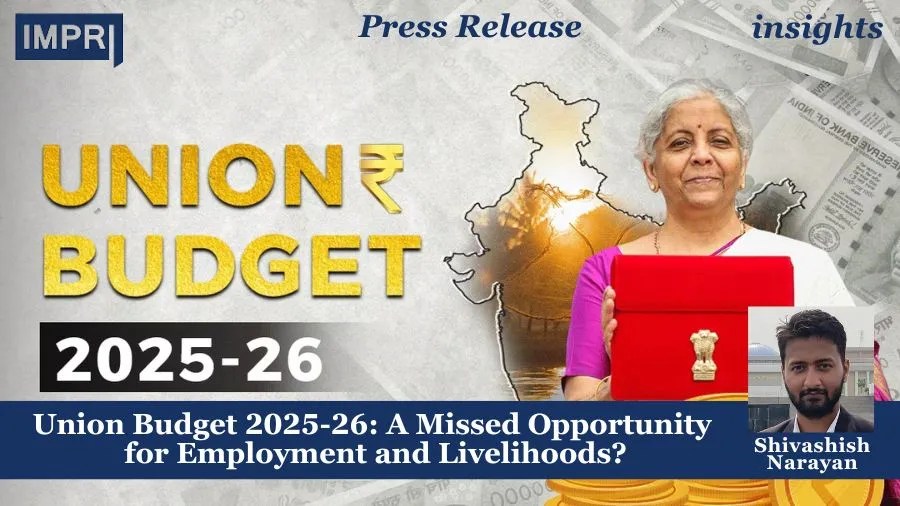By Krishna Jha
Immediately after the happy moments of celebrating our Constitution on January 26 for completing its 75 years, came the budget. The pointers were many but the darkest was the slowdown, continuing and worsening, since last year.
The budget estimated a nominal GDP growth rate of 10.1 per cent in 2025-26. This is nothing but a way to conceal the economic crisis and mislead the nation. For, only about a month back, the National Statistical Organisation (NSO), releasing the first advance estimates of the national income for 2024-25, said that the “real GDP has been estimated to grow by 6.4 percent in FY2024-25”, marking a four-year low and a sharp decline from the 8.2 per cent growth recorded in the fiscal 2023-24. The NSO estimate for the year 2024-25 was lower than even the Reserve Bank of India’s estimate of 6.6 per cent for the fiscal ending March 2025. Making a projection of 10.1 per cent for fiscal 2025-26 is clearly an attempt to present a misleading picture of the economy’s health to the nation.
About debt, the Budget claims that the government aims to reduce its outstanding liabilities to around 50 percent of GDP by March 2031. It also claims to bring down the outstanding liabilities during the 2025-26 to an estimated level of 56.1 percent of the GDP. Once again, these are claims, and the track record of the government is such that it is difficult to believe that the targets could be met.
The crisis deepened since 2019 when the slowdown in growth rate become marked with concerns of our economy being connected with sluggish private consumption and private investment. This period also saw the impact of some major shocks to the economy, including demonetization, the introduction of GST (goods and services Tax) and also lockdown during the Covid period.
Inflation rate gives us a measure of growing impoverishment. Food inflation has averaged 6.18 percent between 2012 and 2024. In October last year, CPI inflation went up to 14-month high at 6.2 per cent from 5.5 per cent in the month of September. It is expected that the MPC would cut repo rate by 25 bps in December. The MPC is waiting for food inflation to ease before cutting policy rates. Persistently elevated food inflation has been a worry.
Healthcare is also not left behind. The healthcare costs have gone up at an annual rate of 14 percent between 2012 and 2024. Similarly, the rate of inflation in education has been around 11percent per annum during this period. According o CMIE, the country wide unemployment rate in December 2024 was 8.1 percent.
The issues are alive while the government has earned a reputation of being pro-corporate and pro-cronies. Within last two years, scheduled banks and commercial banks wrote off loans to corporates amounting to Rs 2,09,144 crore and 1,70,000 crore, respectively.
With inflation going up to 6.2 percent, according to LFPR, the percentage of persons intending to join labour force, working or seeking or are available for work, shot up to a record high of 50.4 per cent in the July-September last year.
This was the second consecutive quarter of a decline in the unemployment rate for urban areas, after the unemployment rate had inched up to 6.7 per cent during January-March last year. This also marked the fifth consecutive quarter of the female unemployment rate remaining above 8 per cent.
The quarterly PLFS data measures labour market indicators such as unemployment rate, LFPR and WPR based on the current weekly status for urban areas. As per the current weekly status, the labour activity status is determined on the basis of a shorter reference period of last seven days preceding the date of survey.
For the annual unemployment and labour force figures under the PLFS, the measure is usually seen for the longer term through the usual status approach. The workforce in the usual status includes the persons who worked for a relatively long part of the 365 days preceding the date of survey and the persons from among the remaining population who worked at least for 30 days during the reference period of 365 days preceding the date of survey.
For the type of employment, the PLFS data showed an improvement for the self-employed workers. The percentage of persons engaged as own account worker and employers increased to 15.3 per cent in July-September from 14.4 per cent in the year ago period but was marginally lower than 15.4 per cent in the previous quarter.
According to the new ILO global estimates, which were released on November 12, an estimated 708 million women are outside the labour force because of unpaid care responsibilities. In 2023, 748 million people (aged 15 years or older) were not participating in the global labour force because of care responsibilities, accounting for a third of all working-age persons outside of the labour force. Of these, 708 million were women and 40 million were men, the UN agency said.
Despite the claim of a fast growth, the truth is that economy is dwindling and has failed to generate employments to young population. (IPA Service)

 2025-26 Budget Is A Cynical Exercise In Manipulating One Group Against The Other
2025-26 Budget Is A Cynical Exercise In Manipulating One Group Against The Other 